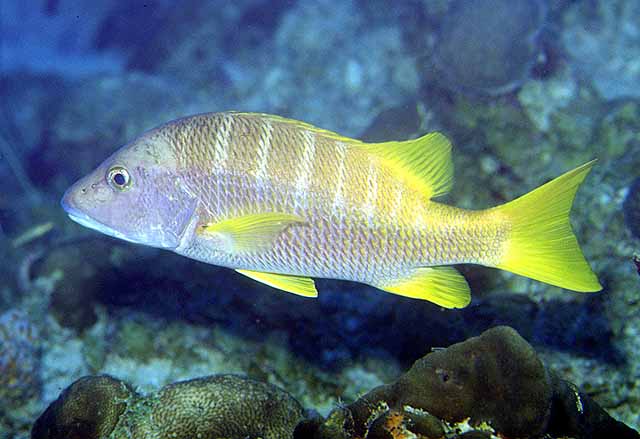| Lutjanidae (Snappers), subfamily: Lutjaninae |
| 79.1 cm FL (male/unsexed); max.weight: 11 kg; max. reported age: 42 years |
|
reef-associated; brackish; marine; depth range 2 - 63 m |
| Western Atlantic: north to Massachusetts, USA (rare in Florida) and south to Trinidad and northern Brazil. |
|
Dorsal spines (total): 10-10; Dorsal soft rays (total): 14-14; Anal spines: 3-3; Anal soft rays: 8-8. Snout long and pointed, mouth large. One of the upper pairs of canine teeth notably enlarged, visible when mouth is close. Preopercular notch and knob weak. Pectoral fins long, reaching the level of anus. Scale rows on back parallel to lateral line, at least anteriorly. Olive gray to brownish on upper back and sides, with eight narrow, pale vertical bars which may be faint or absent in large adults. A solid or broken blue line which may disappear with growth, runs under the eye. |
| Adults occur in shallow, clear, warm, coastal waters over coral reefs. Often near the shelter of elkhorn corals and gorgonians (Ref. 9710). Juveniles are encountered over sand bottoms with or without seagrass (Thalassia), and over muddy bottoms of lagoons or mangrove areas. Young sometimes enter brackish waters. Sometimes form resting aggregations during the day. Feed on fishes, shrimps, crabs, worms, gastropods and cephalopods. Considered a good food fish, it is marketed fresh or frozen (Ref. 55). Maximum length for female taken from Ref. 3093. |
|
Least Concern (LC); Date assessed: 10 October 2015 Ref. (130435)
|
| reports of ciguatera poisoning |
Source and more info: www.fishbase.org. For personal, classroom, and other internal use only. Not for publication.
